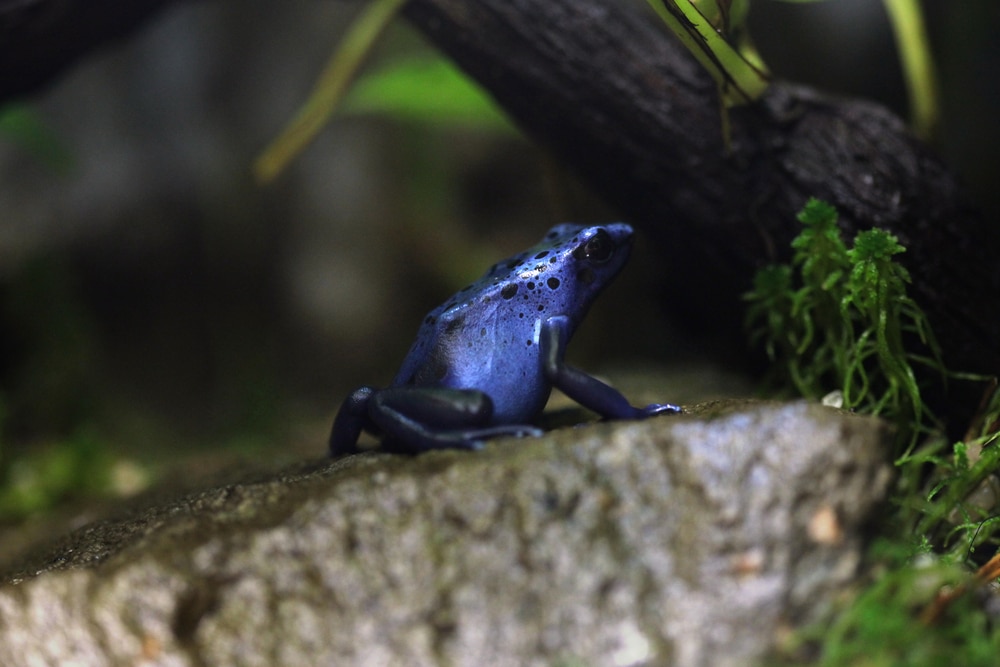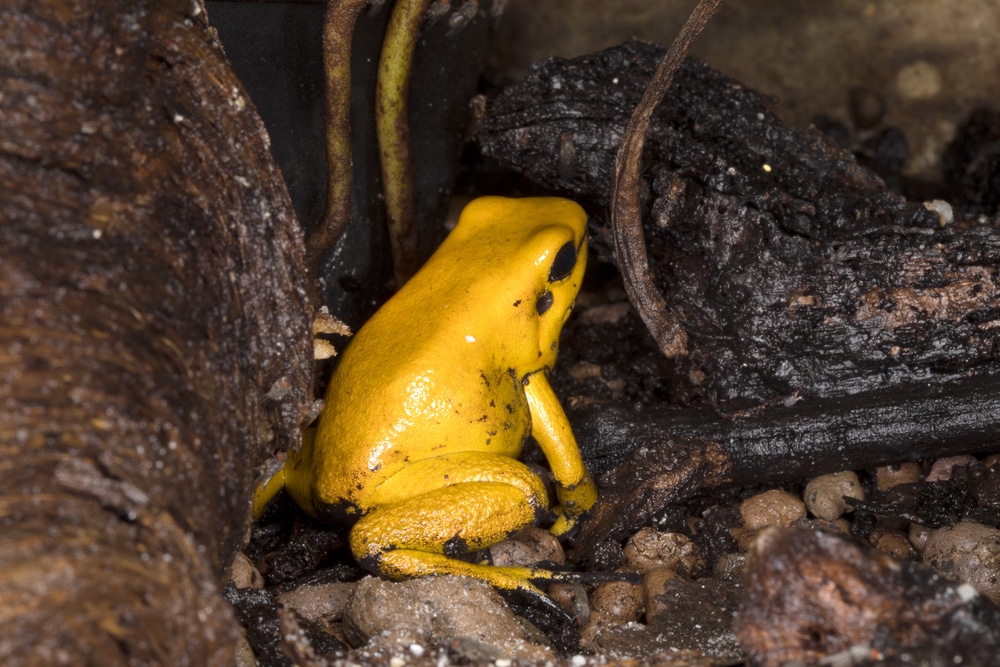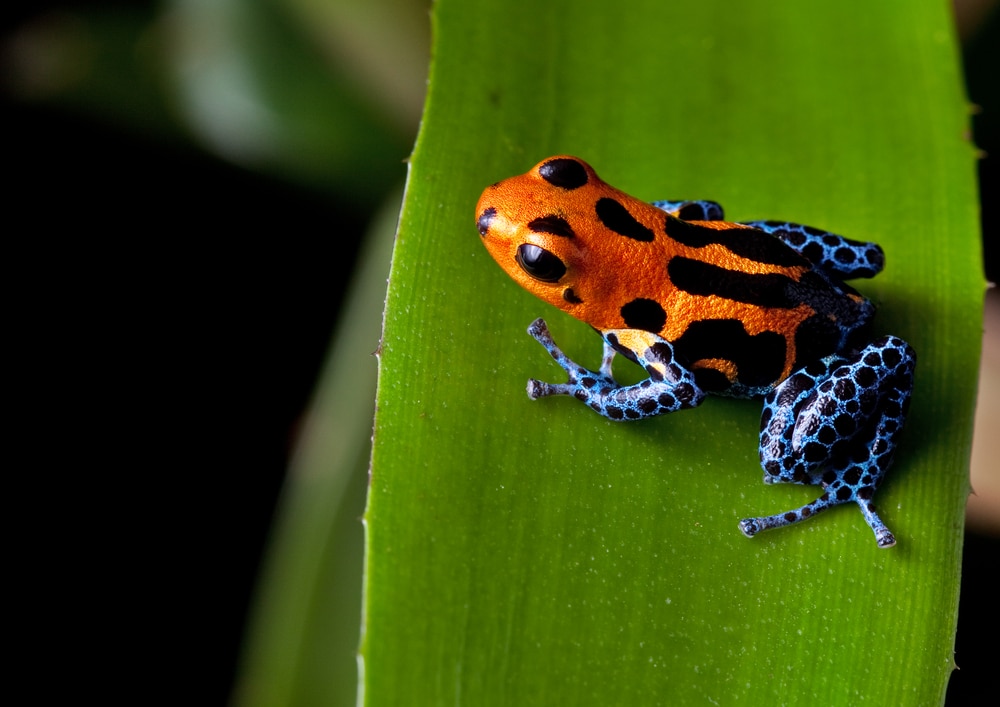Poison dart frogs are some of the most interesting and eye-catching animals available to reptile and amphibian enthusiasts. And while they’re generally not ideal for beginners, they often make excellent pets for keepers with a little bit of experience.
However, dart frogs do present some unique challenges and – given their small size and somewhat delicate nature – they can quickly enter a downward spiral if not provided with appropriate care.

We’ll try to help you care for your new dart frogs below, as we outline the basics of the care they require.
Just note that there are a variety of different dart frog species available to keepers, and they all have slightly different care requirements.
So, while you can rely on the information provided below to guide your efforts, be sure to research the exact needs of the species you keep when designing a care regimen.
Quick Navigation
Safety First: Aren’t These Frogs Poisonous?
Poison dart frogs are infamous for being, well, poisonous. In fact, some species are toxic enough to kill those unfortunate enough to make contact with them.
This begs the question: Why on earth would keepers maintain such deadly pets?
For starters, it is important to note that different poison dart species present different risks – some may indeed be dangerous enough to kill a human, but others are less toxic and unlikely to cause serious symptoms for keepers who accidentally touch them.
For example, the golden poison dart frog (Phyllobates terribilis) is a highly dangerous species, which is thought to be capable of causing a human death in a matter of minutes. Conversely, many other species, such as some members of the genus Colostethus, are thought to be harmless or nearly so.

But unfortunately, most of the harmless or weakly toxic species are clad in drab colors, while the most dangerous species are typically very brightly colored. This means that most hobbyists are usually more interested in caring for the species that present the greatest risk.
However, in practice, poison dart frogs aren’t as dangerous to their keepers as one may initially think. This is because of the mechanism that provides poison dart frogs with their namesake poisons.
Instead of producing their toxins internally the way some other amphibians do, poison dart frogs are thought to produce their toxins by sequestering some of the harmful alkaloids that are present in the insects they consume.
This means that once they’ve been in captivity for some time and fed a diet of commercial insects, most dart frogs cease producing toxic skin secretions. Additionally, captive-bred individuals never produce toxins at all.
Nevertheless, it is still wise to avoid handling poison dart frogs with bare hands.
Not only is it impossible for keepers to know when their frogs have stopped producing the harmful skin secretions, handling any amphibian with bare hands can cause damage to the animal’s skin and health.
Accordingly, it is wise for poison dart frog keepers to use small nets or cups to move or inspect their pets. If this isn’t possible, latex gloves can be used to protect the keeper from the kept and vice versa.
Selecting the Right Enclosure for a Poison Dart Frog
The first thing you’ll need to acquire for your poison dart frogs is a suitable habitat.
There are a number of different enclosure types from which you can choose, including commercially manufactured amphibian cages and plastic storage boxes.
However, the most popular enclosures among most dart frog keepers are glass aquaria.
Glass aquaria do present some drawbacks (they’re heavy and fragile, among other things), but they are usually affordable and provide an excellent view of your pets.
Just be sure that you select an aquarium (or another type of enclosure) that is large enough.
Dart frogs may be quite small and capable of living in relatively tight quarters, but you’ll want to use a fairly roomy enclosure if you intend to keep multiple frogs together or install a lot of plants and other decorations.
A 10-gallon aquarium (or comparably sized storage box) will likely work for one or two dart frogs in a sparsely planted habitat, but a 20-, 30- or 50-gallon tank will provide much more “elbow room” for your pets and allow you to include more plants and decoration.
Obviously, the larger the frogs are and the more frogs you keep together, the larger the habitat will need to be.
Be sure to add a top to the enclosure to prevent your frogs from escaping (and to keep unauthorized hands and pets from accessing your frogs).
You can use a screen lid if necessary, but you may find it necessary to cover a portion of the lid to help keep the humidity level sufficiently high for your pets. Accordingly, solid plastic or glass tops are preferred.
Heating and Lighting
Unlike many other commonly kept reptiles and amphibians, poison dart frogs don’t have hard-to-satisfy heating or lighting requirements.
In fact, there are some occasions in which you won’t even need to provide any supplemental heat or lights at all.
Poison dart frogs usually fare best when maintained at temperatures in the mid-70s. If you keep your home relatively warm, this means you may not need to utilize any heating devices at all.
If you need to raise the temperatures of your dart frog habitat slightly, it is generally wise to do so with a low-wattage heat lamp or a heating pad.
As long as your poison dart frog can see well enough to move around in the habitat and find food, you needn’t provide any supplemental lighting.
However, you may want to install a low-wattage fluorescent light fixture to show off your pets’ color and make it easier to view them.
Just be sure to monitor the habitat temperatures after adding any lights, as even fluorescent fixtures will increase the enclosure temperatures slightly.
Substrate, Cage Decorations and Plants
Now that you have an enclosure and you understand the best way to heat and light the habitat (if necessary), it is time to begin filling it with a substrate and other items.
Substrate

Beginning with the substrate, you’ll have many different options to choose from.
Some of the most common poison dart frog substrates include:
- Organic topsoil or potting soil
- Shredded coconut husk
- Orchid bark
- Cypress mulch
- Gravel
- Sphagnum moss
All substrates present different benefits and drawbacks, so you’ll need to consider your specific needs and desires when making a choice.
Soils and coconut husks are likely the most common choices among dart frog keepers, as they’re very affordable and attractive.
However, these types of substrates will eventually rot and require replacement, so other keepers opt for gravel, which is still attractive, yet not susceptible to rot.
Once you’ve selected a substrate and added a thick layer of it to the habitat, you can begin to add furniture and plants to the enclosure.
Plants

You can add a variety of different things to your dart frog’s habitat, such as:
- Wooden branches
- Cork bark
- Rocks or large pebbles
- Moss
- Commercial cage decorations
- Cleaned animal bones or skulls
- Water features (ponds, waterfalls, etc.)
Just be sure to clean any furniture you intend to add to the habitat thoroughly before adding it.
In addition to these items, you can (and should) add some live plants to your dart frog’s habitat. There are dozens (if not hundreds) of plant species that’ll work in most dart frog enclosures, so you’ll want to take the time to select the best species for your situation.
We’ve discussed some of the best plants for reptile and amphibian enclosures here, but a few of the best options include:
- Golden pothos (Epipremnum aureum)
- Urn plants (Aechmea recurvata)
- Nest fern (Asplenium nidus)
- Boston fern (Nephrolepis exaltata)
- Ivy philodendron (Philodendron hederaceum)
Of course, you can also use artificial plants if you like. They won’t contribute to the air-quality of humidity level in the habitat, but they will still provide visual barriers and hiding places for your pets and help improve the aesthetics of the habitat.
Water & Hydration
Poison dart frogs require water, but they satisfy these requirements by absorbing moisture through their skin and cloaca. This means that they don’t drink water at all.
In the wild, dart frogs likely obtain all of the water they need by simply absorbing water from the ground and surrounding air. This is part of the reason you’ll need to ensure your dart frog enclosure has a very high humidity level – typically between 80% and 100%.
You can maintain such a high humidity level by misting the enclosure regularly, installing a number of live plants (which will draw water from the substrate and release it into the air), and by limiting the amount of ventilation allowed in the enclosure.
You do not need to include a water dish for your frogs, but you can do so if you wish. Just be sure to use a very shallow container (dart frogs are poor swimmers, who can easily drown) and fill it with dechlorinated or bottled water.
It is also imperative that you keep the water and the bowl very clean to prevent your frog from developing a bacterial infection.
You may never see your frog entering the water dish, but it will still help raise the humidity level in the habitat and provide a good safety feature your frogs can use if the humidity level drops temporarily.
Feeding Your Poison Dart Frog
Feeding poison dart frogs is pretty easy – the biggest challenge is finding suitable prey. Dart frogs are quite small, so they require very small prey.
Some keepers offer their dart frogs tiny (pinhead) crickets, but most keepers who have long-tern success feed their frogs flightless fruit flies.
You’ll usually want to maintain a breeding colony of fruit flies, as this will provide a ready supply of the insects and prevent you from having to drive to the pet store multiple times a week.
Most retailers who sell fruit flies will include instructions for maintaining the colony, but it often requires a bit of practice to get things right.
Accordingly, it is wise to order more than you’ll need at the outset.
Feed young dart frogs every day, but established adults can be fed about five times per week.
Because fruit flies are very small, you’ll need to provide your frogs with a large number of insects at each feeding. Young frogs may need 20 to 30 fruit flies per individual per meal, while adults may be able to polish off 50 or more fruit flies a day.
Fortunately, fruit flies aren’t harmful to dart frogs, so it isn’t a big deal if you accidentally add too many to the habitat. Just be sure to provide a slightly smaller quantity on the next feeding to avoid overcrowding the tank with bugs.
Is It Safe to Keep Different Poison Dart Frog Species Together?
Some zoos and experienced keepers maintain multi-species dart frog enclosures, but beginners are often advised to avoid doing so. There are a few reasons for this, including:
- Poison dart frogs are often territorial animals. When forced to live in close quarters with members of other species, poison dart frogs may become aggressive with each other. This may lead to injuries or intimidation, which can prevent some of your frogs from eating or accessing various portions of the habitat.
- Poison dart frogs from different regions may have different illnesses or parasites. Generally speaking, it is not wise to keep animals from different geographic areas in the same habitat, as it’ll increase the chances that one or more will fall ill from parasites, bacteria or viruses that they’ve not adapted to live with. This is slightly less dangerous with captive-bred animals, but a small risk still remains.
- Different poison dart frog species may hybridize. Many poison dart frog species are capable of interbreeding with other, closely related species. This won’t present a threat to the health of your frogs, but it will leave you with hybrid young, who are often more difficult to sell.
If you still intend on keeping different frog species together in the same enclosure, be sure that you select species with similar habitat requirements, only use captive-bred specimens, and do your best to avoid triggering breeding activity.
Conclusion
As you can see, poison dart frogs do present some challenges to their keepers, but they still make fantastic pets for keepers willing to invest the time and resources these frogs require.
Just be sure to select the species you keep carefully and set up the habitat properly from the outset.
This will help give you the best chance of success and ensure your frogs have the highest quality of life possible.